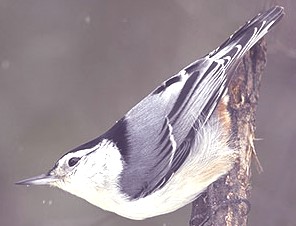White-breasted Nuthatches are small, insectivorous bark gleaners which also eat plant materials such as acorns and nuts. Although the species is generally resident, northern and western populations may irrupt in some years (Pravosudov and Grubb 1993). This nuthatch breeds in northeast Texas and the mountains of the Trans-Pecos with only one confirmed breeding record between, in the eastern Panhandle. These eastern and western population apparently belong to different groups described in the AOU Checklist of North American birds which identifies 3 groups (eastern, interior montane and Pacific Coast) with vocal, morphological and ecological differences (Am. Ornithol. Union 1998).
DISTRIBUTION. During the 1987-1992 field work of the TBBA project, volunteers found most White-breasted Nuthatches in Texas breed in the Pineywoods, (mostly north and central parts) and adjacent portions of the Post Oak Savannah regions (see the region map in Lockwood and Freeman [2004]). Breeding was also confirmed in the Davis and Guadalupe mountains of the Trans–Pecos and in the eastern Panhandle. North American Breeding Bird Survey (BBS) data from 13 routes produce a map similar to the TBBA map with the highest relative abundance (1-3 nuthatches per route) in east Texas and averages of <1 per route around the area of highest abundance and in the Trans-Pecos mountains (Sauer et al. 2005).
Texas is the southeast corner of this species range in eastern North American which extends west from Nova Scotia to Manitoba and south to the Gulf Coast states. In western North America this species breeds from the Pacific Coast east to the Black Hills of South Dakota and the Rocky Mountains and south to northern Baja California and though the highlands of mainland Mexico to the Isthmus of Tehuantepec (Howell and Webb 1995, Sauer 2005).
SEASONAL OCCURRENCE. White- breasted Nuthatches are resident in their limited breeding areas in this state. The breeding season is from early March to late June, perhaps later. Eggs have been collected from March 26 to April 2 (Oberholser 1974). TBBA atlasers found recently fledged young as early as March 27 in east Texas. .
In contrast to this data from the east, in Arizona atlasers found breeding evidence for this nuthatch mostly between late April and the end of July (Spence 2004), suggesting the possibility eastern and western populations of this nuthatch have different breeding phenologies and that White-breasted Nuthatch in the Trans-Pecos mountains may breed at a different time than in the Pineywoods.
BREEDING HABITAT. Oberholser (1974) reports this nuthatch breeds from low elevations to as high as 2700 m (8500 ft) in Texas. In eastern North America, this species nests in deciduous or mixed deciduous/coniferous woodlands, often at edges or openings (Pravosudov and Grubb 1993). In the interior west in Arizona 70% o breeding records for this species came from coniferous forest habitats and 18% came from deciduous woodlands (Spence 2005), while in Colorado about 68% of breeding evidence came from coniferous habitats and 19% came from deciduous habitats (Kuennin 1998).
White-breasted Nuthatches breed in natural cavities in trees, old woodpecker holes and occasionally nest boxes. The cavity is lined with various materials such as bark shreds, twigs, grasses, hair and feathers. In the cup she has formed, the female usually lays 7-8 (range 5-10) white eggs, usually spotted with reds or browns. The eggs look like those of the Red-breasted Nuthatch (S. canadensis) but are larger. The female, fed by the male, incubates the eggs for 12-14 days and the young leave the nest 26 days after hatching and then stay with their parents for several weeks. Only one brood is raised per year and brood parasitism is rare (Harrison 1979, Pravosudov and Grubb 1993).
STATUS. The species formerly bred on the Edwards Plateau and in the Big Bend area as well as further west and south in eastern Texas. Much of this range contraction apparently occurred before 1950 (Oberholser 1974). Currently White-breasted Nuthatch is considered locally uncommon in northeast Texas and common to uncommon in the Trans-Pecos mountains (Lockwood and Freeman 2004).
BBS data from Texas are too limited to provide a robust population trend estimate for 1980-2005, but data from 26 routes in adjacent Oklahoma produce a statistically significant +5.0% annual population change for that period. The statistically significant population trends derived from 1248 routes in eastern North America and 1824 across the United States and Canada are more modest, +1.1% and 1.3%, respectively, for the same period (Sauer et al. 2005). These figures suggest the current status of this species in Texas is probably at least stable.
Text by Robert C. Tweit (2006)
Literature cited:
American Ornithologists’ Union. 1998. Checklist of North American birds, 7th ed. Am, Ornithol. Union, Washington, DC.
Harrison, H. H. 1979. A field guide to western birds’ nests. Houghton Mifflin, Boston, MA.
Howell, S. N. G. and S. Webb. 1995. A guide to the birds of Mexico and northern Central America. Oxford University Press, New York.
Kuenning, R. R. 1998. White-breasted Nuthatch (Sitta carolinensis). In Colorado breeding bird atlas, pp. 358-359 (H. E. Kingery, ed.). Colorado Bird Atlas Partnership, Denver.
Lockwood, M. W. and B. Freeman. 2004. The TOS handbook of Texas birds. Texas A&M University Press, College Station.
Oberholser, H. C. 1974. The bird life of Texas. University of Texas Press, Austin.
Pravosudov, V. V. and T. C. Grubb, Jr. 1993. White-breasted Nuthatch (Sitta carolinensis). In The birds of North America, No. 54 (A. Poole and F. Gill, eds.). The Birds of North America, Inc., Philadelphia, PA.
Sauer, J. R., J. E. Hines, and J. Fallon. 2005. The North American Breeding Bird Survey, results and analysis 1966-2005. Version 6.2 2006. USGS Patuxent Wildlife Research Center, Laurel MD < http://www.mbr-pwrc.usgs.gov/bbs>
Spence, J. R. 2005. White-breasted Nuthatch (Sitta carolinensis). In Arizona breeding bird atlas. pp. 396-397 (T. E. Corman and C. Wise-Gervais, eds.). University of New Mexico Press, Albuquerque.

